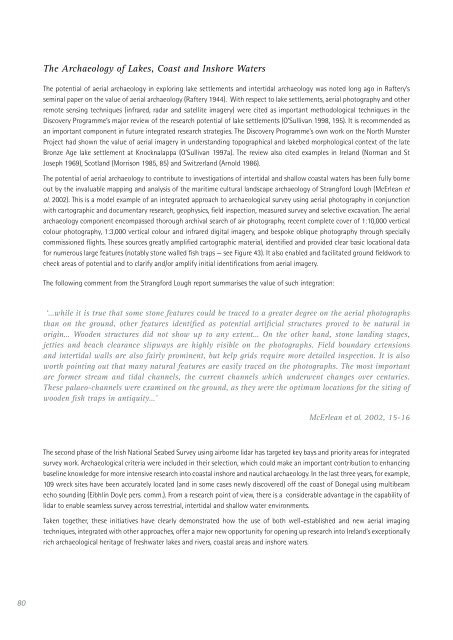Aerial Archaeology in Ireland - The Heritage Council
Aerial Archaeology in Ireland - The Heritage Council
Aerial Archaeology in Ireland - The Heritage Council
Create successful ePaper yourself
Turn your PDF publications into a flip-book with our unique Google optimized e-Paper software.
80<br />
<strong>The</strong> <strong>Archaeology</strong> of Lakes, Coast and Inshore Waters<br />
<strong>The</strong> potential of aerial archaeology <strong>in</strong> explor<strong>in</strong>g lake settlements and <strong>in</strong>tertidal archaeology was noted long ago <strong>in</strong> Raftery’s<br />
sem<strong>in</strong>al paper on the value of aerial archaeology (Raftery 1944). With respect to lake settlements, aerial photography and other<br />
remote sens<strong>in</strong>g techniques (<strong>in</strong>frared, radar and satellite imagery) were cited as important methodological techniques <strong>in</strong> the<br />
Discovery Programme’s major review of the research potential of lake settlements (O’Sullivan 1998, 195). It is recommended as<br />
an important component <strong>in</strong> future <strong>in</strong>tegrated research strategies. <strong>The</strong> Discovery Programme’s own work on the North Munster<br />
Project had shown the value of aerial imagery <strong>in</strong> understand<strong>in</strong>g topographical and lakebed morphological context of the late<br />
Bronze Age lake settlement at Knocknalappa (O’Sullivan 1997a). <strong>The</strong> review also cited examples <strong>in</strong> <strong>Ireland</strong> (Norman and St<br />
Joseph 1969), Scotland (Morrison 1985, 85) and Switzerland (Arnold 1986).<br />
<strong>The</strong> potential of aerial archaeology to contribute to <strong>in</strong>vestigations of <strong>in</strong>tertidal and shallow coastal waters has been fully borne<br />
out by the <strong>in</strong>valuable mapp<strong>in</strong>g and analysis of the maritime cultural landscape archaeology of Strangford Lough (McErlean et<br />
al. 2002). This is a model example of an <strong>in</strong>tegrated approach to archaeological survey us<strong>in</strong>g aerial photography <strong>in</strong> conjunction<br />
with cartographic and documentary research, geophysics, field <strong>in</strong>spection, measured survey and selective excavation. <strong>The</strong> aerial<br />
archaeology component encompassed thorough archival search of air photography, recent complete cover of 1:10,000 vertical<br />
colour photography, 1:3,000 vertical colour and <strong>in</strong>frared digital imagery, and bespoke oblique photography through specially<br />
commissioned flights. <strong>The</strong>se sources greatly amplified cartographic material, identified and provided clear basic locational data<br />
for numerous large features (notably stone walled fish traps — see Figure 43). It also enabled and facilitated ground fieldwork to<br />
check areas of potential and to clarify and/or amplify <strong>in</strong>itial identifications from aerial imagery.<br />
<strong>The</strong> follow<strong>in</strong>g comment from the Strangford Lough report summarises the value of such <strong>in</strong>tegration:<br />
‘…while it is true that some stone features could be traced to a greater degree on the aerial photographs<br />
than on the ground, other features identified as potential artificial structures proved to be natural <strong>in</strong><br />
orig<strong>in</strong>… Wooden structures did not show up to any extent… On the other hand, stone land<strong>in</strong>g stages,<br />
jetties and beach clearance slipways are highly visible on the photographs. Field boundary extensions<br />
and <strong>in</strong>tertidal walls are also fairly prom<strong>in</strong>ent, but kelp grids require more detailed <strong>in</strong>spection. It is also<br />
worth po<strong>in</strong>t<strong>in</strong>g out that many natural features are easily traced on the photographs. <strong>The</strong> most important<br />
are former stream and tidal channels, the current channels which underwent changes over centuries.<br />
<strong>The</strong>se palaeo-channels were exam<strong>in</strong>ed on the ground, as they were the optimum locations for the sit<strong>in</strong>g of<br />
wooden fish traps <strong>in</strong> antiquity…’<br />
McErlean et al. 2002, 15-16<br />
<strong>The</strong> second phase of the Irish National Seabed Survey us<strong>in</strong>g airborne lidar has targeted key bays and priority areas for <strong>in</strong>tegrated<br />
survey work. Archaeological criteria were <strong>in</strong>cluded <strong>in</strong> their selection, which could make an important contribution to enhanc<strong>in</strong>g<br />
basel<strong>in</strong>e knowledge for more <strong>in</strong>tensive research <strong>in</strong>to coastal <strong>in</strong>shore and nautical archaeology. In the last three years, for example,<br />
109 wreck sites have been accurately located (and <strong>in</strong> some cases newly discovered) off the coast of Donegal us<strong>in</strong>g multibeam<br />
echo sound<strong>in</strong>g (Eibhl<strong>in</strong> Doyle pers. comm.). From a research po<strong>in</strong>t of view, there is a considerable advantage <strong>in</strong> the capability of<br />
lidar to enable seamless survey across terrestrial, <strong>in</strong>tertidal and shallow water environments.<br />
Taken together, these <strong>in</strong>itiatives have clearly demonstrated how the use of both well-established and new aerial imag<strong>in</strong>g<br />
techniques, <strong>in</strong>tegrated with other approaches, offer a major new opportunity for open<strong>in</strong>g up research <strong>in</strong>to <strong>Ireland</strong>’s exceptionally<br />
rich archaeological heritage of freshwater lakes and rivers, coastal areas and <strong>in</strong>shore waters.

















